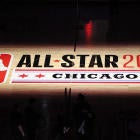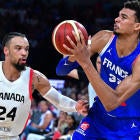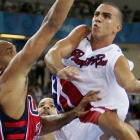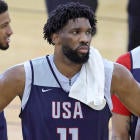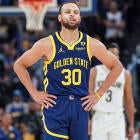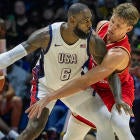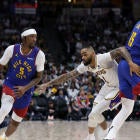CHICAGO -- Nick Elam remembers having his notebook out, ready to go. He was at Philadelphia University for The Basketball Tournament's play-in games, watching an idea he'd dreamed up a decade earlier come to life. At the first dead ball after four-minute mark of the fourth quarter, the clock would be turned off, and both teams would compete to meet the target score, seven points greater than the score of the leading team. Having studied the endings of thousands of regular games, Elam was fully expecting to be in research mode.
"I don't think I marked down anything," Elam told CBS Sports. "I went back later and watched the ESPN3 broadcast and gathered all my data. But I realized when I was there, I was like, all right, I'm just going to take this all in."
Elam said this on Friday, about 48 hours before he will see his idea, the Elam Ending, on a much bigger stage. On Sunday, for the first time in the history of the NBA All-Star Game, the entire fourth quarter will be played without a running clock. Team LeBron and Team Giannis will play to a target score of 24 points greater than the leading team's total in the first three quarters. For Elam and TBT founder Jon Mugar, who also spoke to CBS Sports ahead of the game, the hope is that this is just the next step for the concept.
"After having sat through now 134 Elam Ending games, it's just unequivocally better," Mugar said.
The gist of the origin story: Elam cold-emailed everyone he could think of with his idea, and Mugar opened the one addressed to info@thetournament.com. Attached was a 67-point PowerPoint presentation, which Mugar read at the perfect time. He had been looking for a way to address the rampant late-game fouling in TBT games.
Elam is a Mensa member and a professor at Ball State who worked on the Cincinnati Reds groundskeeping crew simultaneously to becoming a teacher and a school principal. Before starting TBT, Mugar was a comedy writer and producer -- his IMDB page is full of credits on "Tim and Eric Awesome Show, Great Job!" Elam is a die-hard fan of the show.
"It was great from the get-go," Mugar said. "I think we share a lot in common. Except I'm not anywhere close to being Mensa."
The biggest challenge facing the Elam Ending, Mugar said, is that there is no historical precedent. When he watched that first game in Philadelphia, he was "hiding behind the bleachers or something," a nervous wreck worried about the referees' comfort level. Before the TBT went all-in the following season, he wanted to know that everyone involved was committed to it. After eavesdropping on conversations in the stands, he is a believer.
"As long as people give it a shot, I feel very optimistic that someday it's going to be everywhere in basketball," Mugar said. "For Sunday night, that's an exhibition game, obviously the stakes aren't high, so it's a much different feel. I don't have any delusions that it happening on Sunday will lead to widespread adoption, but I will say if there happens to be a great finish -- maybe there's a 20 percent chance that there's an amazing finish because of the Elam Ending -- that's something that everyone's going to jot away at the back of their minds, from fans to organizers to players. And this problem of prolonged games going down to the wire is not going away. So if it goes well on Sunday, I just think it's going to expedite the time frame."
The idea may be Elam's baby, but he insists he has looked at it with a critical eye all along. At the beginning, he even thought it seemed gimmicky himself. The more he thought about it, though, the more he saw it as "an anti-gimmick," which produces "a style of play that is less gimmicky than what we see at the end of games now," Elam said. The tough part was making others see It his way.
At this point, though, both Elam and Mugar have honed their pitches. According to Elam, there are five primary aims of the Elam Ending: stopping trailing teams from fouling deliberately, stopping leading teams from stalling, reducing rushed and sloppy end-of-game possessions, increasing the likelihood of late comebacks and creating more memorable game-ending moments. It has been successful on all these fronts in the TBT.
"If Naismith invented the game 130 years ago with the Elam Ending and someone came along 130 years later and tried to implement the timed ending, it would be like the biggest, most massive failure of all-time, with players hitting each other, everything going to the free-throw line," Mugar said. "Fans would storm out after one game and say, 'This is the dumbest thing ever.'"
In between the 2017 and 2018 tournaments, Mugar casually informed Elam in a phone conversation that Chris Paul loved the idea. Earlier, Paul's brother, C.J., had emailed that same info@thetournament.com address to say that Paul was a huge fan. Paul coached a TBT team in 2019 and met Elam at a championship-week game in Chicago last August. "As excited as I was to meet him, he acted more excited to meet me," Elam said. More consequentially, Paul called NBA commissioner Adam Silver and suggested using the Elam Ending in the All-Star Game.
As valuable as it is to have Paul as an advocate, Elam would still like to have a seat at the table with the NBA. He is convinced that, if the league has questions, he can offer informed answers based on his research. He would also like the league to acknowledge him in a lasting way.
"I want the Elam Ending name to live on," Elam said. "I'm thrilled that they are using my idea, but I don't want them to steal my idea."
Mugar doesn't necessarily think that the Elam Ending will incentivize All-Stars to play harder -- that has more to do with stakes. He knows deep down that it doesn't really matter whether or not the enormous audience sees something incredible on Sunday, and that chances are it won't. This did not stop him from joking that he'll be hiding under the bleachers again.
"It's best viewed over a long sample size," Mugar said. "But I'm going to want it to go well, and I'm going to be nervous."
Elam prefers the TBT format -- it now adds eight points to the winning team's total with four minutes remaining to get to the target score -- to the one that will be on display in the All-Star Game: "You feel the finish line there, and people get on their feet and they stay there for the whole final stretch." Shutting the clock off for the entire fourth quarter might not create the same sense of urgency when untimed play begins. He also cautioned that the fourth quarter could zoom by. Initially, on Jan. 23, the league informed him that it was planning to use a plus-35 model, to simulate a regular fourth-quarter score, but that was changed to plus-24 after the helicopter crash that killed Kobe Bryant.
"I just hope the game is close going into the fourth quarter 'cause, man, don't blink," Elam said. "Because that fourth quarter is going to be over quick."
Regardless of how long it takes, Elam will be attuned to the atmosphere at the United Center. Part of this for obvious, sentimental reasons, and part of it is practical. After attending TBT games, he has learned that it's more valuable to feel how the crowd reacts to the Elam Ending than it is to dissect everything possession by possession in real time. The All-Star Game will be recording at home, but he will not have his notepad out at his seat.
"I'm just going to soak it all in," Elam said.









